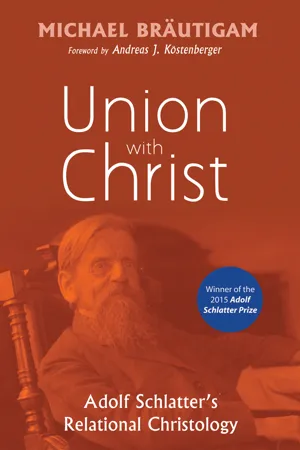![]()
Part 1
The Genesis and Context of Schlatter’s Christology
“Theological history” writes Münster systematician Eckard Lessing is “personal history.” While this is certainly correct, one could add that the converse is also true: personal history is theological history. Lessing points to the various autobiographical accounts by German Protestant theologians of the latter half of the nineteenth century, and claims that their theological agendas were meant to be read against the backdrop of their personal and general history. This is certainly true in the case of Adolf Schlatter. When studying Schlatter, one needs to take into account his own life context, the “unity of [his] biblically rooted theology and [his] biography,” as Peter Stuhlmacher remarks. Schlatter himself penned several autobiographical volumes with the declared intention to disclose what shaped his theological thinking. He clearly points out that his theological outlook and particular method were given to him through his history. To neglect Schlatter’s biographical context then would be an unwise move as he himself, as it were, expects the readers of his theological œuvre to be familiar with his own story, his Geschichte. For Schlatter, theology and life, thinking-act (Denkakt) and life-act (Lebensakt), form an inseparable union. As it is impossible to do justice to Adolf Schlatter’s theology without adequately taking into account his personal historical context, this study is thus not merely a task in dogmatic theology but also a historical and, if you will, a psychological exercise. Understanding Schlatter’s life, to which we now turn, is the key to unlocking the overarching elements of his theological, and in particular, christological agenda.
![]()
1
Who was Adolf Schlatter?
Biography and Theology
The Sitz im Leben of Schlatter’s Theology (1852–75)
Adolf Schlatter was born in St. Gallen, Switzerland, on August 16, 1852, the seventh child of Hektor Stephan Schlatter (1805–80) and Wilhelmine, née Steinmann (1819–94). In the following nearly eighty-six years of his life as pastor, professor, author and speaker, Adolf Schlatter would continue the family’s Protestant tradition, his family line being traceable to the fifteenth century reformer Joachim Vadian (1484–1551). To a great extent, Schlatter’s theology has its Sitz im Leben in the Christian home of his youth. “The power with which we children were embraced by our parents’ faith,” remembers Schlatter later, “was the presupposition and root from which my own story [Geschichte] grew.” His parents lived out the union of faith and love, the unity of orthodoxy and orthopraxy, which would leave an indelible impression on their son. Still, despite their close fellowship in faith, Schlatter’s parents were confessionally divided. Complaining of a lack of church discipline, Stephan Schlatter left the Reformed Church, joined an Evangelical Free Church, and was re-baptized. Even though his wife had sympathies for the Free Church, she could not follow her husband and remained with the children in the established Reformed Church. Obviously, this painful split affected the young Schlatter. It might explain why he never became a clear-cut confessional theologian, rather embodying a lifelong ecumenical openness. Overall, however, for Schlatter’s parents personal allegiance to Jesus Christ by faith was paramount and took priority over any denominational affiliations. This has undoubtedly contributed to Schlatter’s strong Christocentric focus. An irenic theologian, he would throughout his career labor for the unity of the church, seeking fellowship with those with whom he knew himself united by faith in Christ, regardless of their different ecclesial backgrounds. His father, a trained pharmacist, inspired Schlatter with his love for nature, for the natural sciences, and for botany in particular. “My eyes, therefore,” remembers Schlatter, “were opened to nature at an early age, for God had given me parents who praised him with earnest faith as the Creator of nature.” This early exposure to the natural realm set the course for his later philosophical-realist stance against any contemporary Kantian approaches and contributed to his development of an empirical “theology of facts.” Overall, in his boyhood home, Schlatter was equipped with a view for the broad range of God’s revelation in creation, which certainly influenced his overall theological perspective, the “impetus towards the whole” (Richtung auf das Ganze), as he would later describe it in his “Christian Dog...
